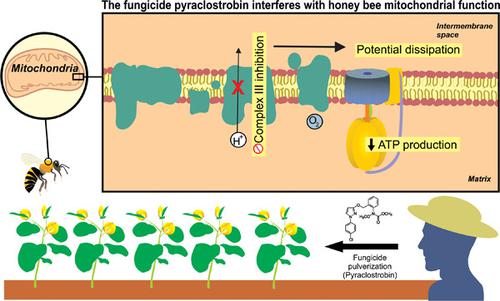当前位置:
X-MOL 学术
›
Environ. Toxicol. Chem.
›
论文详情
Our official English website, www.x-mol.net, welcomes your
feedback! (Note: you will need to create a separate account there.)
Mitochondrial Respiratory Inhibition Promoted by Pyraclostrobin in Fungi is Also Observed in Honey Bees.
Environmental Toxicology and Chemistry ( IF 3.6 ) Pub Date : 2020-04-02 , DOI: 10.1002/etc.4719 Daniel Nicodemo 1 , Fábio Erminio Mingatto 1 , David De Jong 2 , Paulo Francisco Veiga Bizerra 1 , Marco Aurélio Tavares 1 , William Cesar Bellini 1 , Eduardo Festozo Vicente 3 , Amanda de Carvalho 1
Environmental Toxicology and Chemistry ( IF 3.6 ) Pub Date : 2020-04-02 , DOI: 10.1002/etc.4719 Daniel Nicodemo 1 , Fábio Erminio Mingatto 1 , David De Jong 2 , Paulo Francisco Veiga Bizerra 1 , Marco Aurélio Tavares 1 , William Cesar Bellini 1 , Eduardo Festozo Vicente 3 , Amanda de Carvalho 1
Affiliation

|
There is no use restriction associated with bees for many fungicides used in agriculture; however, this does not always mean that these pesticides are harmless for these nontarget organisms. We investigated whether the fungicide pyraclostrobin, which acts on fungal mitochondria, also negatively affects honey bee mitochondrial bioenergetics. Honey bees were collected from 5 hives and anesthetized at 4 °C. The thoraces were separated, and mitochondria were isolated by grinding, filtering, and differential centrifugation. An aliquot of 0.5 mg of mitochondrial proteins was added to 0.5 mL of a standard reaction medium with 4 mM succinate (complex II substrate) plus 50 nM rotenone (complex I inhibitor), and mitochondrial respiration was measured at 30 °C using a Clark-type oxygen electrode. Mitochondrial membrane potential was determined spectrofluorimetrically using safranin O as a probe, and adenosine triphosphate (ATP) synthesis was determined by chemiluminescence. Pyraclostrobin at 0 to 50 μM was tested on the mitochondrial preparations, with 3 repetitions. Pyraclostrobin inhibited mitochondrial respiration in a dose-dependent manner at concentrations of 10 μM and above, demonstrating typical inhibition of oxidative phosphorylation. Pyraclostrobin also promoted a decline in the mitochondrial membrane potential at doses of 5 μM and above and in ATP synthesis at 15 μM and above. We conclude that pyraclostrobin interferes with honey bee mitochondrial function, which is especially critical for the energy-demanding flight activity of foraging bees. Environ Toxicol Chem 2020;39:1267-1272. © 2020 SETAC.
中文翻译:

蜜蜂中还发现了吡菌酯在真菌中促进的线粒体呼吸抑制作用。
对于农业上使用的许多杀真菌剂,没有与蜜蜂相关的使用限制;但是,这并不总是意味着这些农药对这些非目标生物无害。我们调查了作用于真菌线粒体的杀菌剂吡菌酯是否也对蜜蜂的线粒体生物能产生负面影响。从5个蜂巢中收集蜜蜂,并在4°C麻醉。分离胸廓,并通过研磨,过滤和差速离心分离线粒体。将0.5 mg线粒体蛋白的等分试样添加到0.5 mL含4 mM琥珀酸酯(复合物II底物)和50 nM鱼藤酮(复合物I抑制剂)的标准反应介质中,并在30°C下使用Clark-型氧电极。使用番红O作为探针,通过荧光荧光法测定线粒体膜电位,并通过化学发光法测定三磷酸腺苷(ATP)的合成。对线粒体制剂测试0至50μM的吡菌酯,重复3次。吡菌酯在浓度大于等于10μM时以剂量依赖的方式抑制线粒体呼吸,这表明氧化磷酸化的典型抑制作用。吡咯菌酯还促进了5μM及以上剂量时线粒体膜电位的下降以及15μM及以上剂量下ATP的合成。我们得出的结论是吡唑醚菌酯会干扰蜜蜂的线粒体功能,这对于觅食蜜蜂的能量需求飞行活动尤其重要。Environ Toxicol Chem 2020; 39:1267-1272。©2020 SETAC。
更新日期:2020-04-02
中文翻译:

蜜蜂中还发现了吡菌酯在真菌中促进的线粒体呼吸抑制作用。
对于农业上使用的许多杀真菌剂,没有与蜜蜂相关的使用限制;但是,这并不总是意味着这些农药对这些非目标生物无害。我们调查了作用于真菌线粒体的杀菌剂吡菌酯是否也对蜜蜂的线粒体生物能产生负面影响。从5个蜂巢中收集蜜蜂,并在4°C麻醉。分离胸廓,并通过研磨,过滤和差速离心分离线粒体。将0.5 mg线粒体蛋白的等分试样添加到0.5 mL含4 mM琥珀酸酯(复合物II底物)和50 nM鱼藤酮(复合物I抑制剂)的标准反应介质中,并在30°C下使用Clark-型氧电极。使用番红O作为探针,通过荧光荧光法测定线粒体膜电位,并通过化学发光法测定三磷酸腺苷(ATP)的合成。对线粒体制剂测试0至50μM的吡菌酯,重复3次。吡菌酯在浓度大于等于10μM时以剂量依赖的方式抑制线粒体呼吸,这表明氧化磷酸化的典型抑制作用。吡咯菌酯还促进了5μM及以上剂量时线粒体膜电位的下降以及15μM及以上剂量下ATP的合成。我们得出的结论是吡唑醚菌酯会干扰蜜蜂的线粒体功能,这对于觅食蜜蜂的能量需求飞行活动尤其重要。Environ Toxicol Chem 2020; 39:1267-1272。©2020 SETAC。











































 京公网安备 11010802027423号
京公网安备 11010802027423号